|
Spitfire Mk.VIII

Eduard ProfiPACK, 1/48 scale
S
u m m a r y |
| Catalogue Number: |
Eduard Kit No. 8284 - Spitfire Mk.VIII |
| Scale: |
1/48 |
| Contents and Media: |
207 parts in grey coloured plastic; 17 parts in clear; colour photo-etched fret; self-adhesive die-cut masking sheet; markings for six aircraft |
| Price: |
USD$42.46 plus shipping,
available online from Eduard |
| Review Type: |
FirstLook |
| Advantages: |
Accurate fuselage and wing dimensions; very high level of detail; outstanding surface
features including crisply recessed panels and subtle rivet lines where
appropriate; brand new fuselage and wings depicting subtle changes to the Mk.VIII; optional HF pointed wing tips; separate parts for closed and open canopy. |
| Disadvantages: |
|
| Conclusion: |
Eduard's Mk.IX kits were the best Spitfires in 1/48 scale upon their release, and they still are today. This new Spitfire Mk.VIII is equally good. Eduard has gone the whole nine yards with their brand new fuselage and wings depicting the unique attributes of this later variant.
Highly Recommended. |
Reviewed by Brett Green

Eduard's 1/48 scale Spitfire Mk.VIII will be available online from Squadron.com
The Spitfire Mk.VIII actually entered service after the Mk.IX.
Compared to the Mk.IX, the new and improved Mk.VIII featured a strengthened fuselage and retractable tail wheel. It was fitted with the new Volkes Aero Vee air filter, which was also adapted to the later production Spitfire Mk.IX. Each wing was fitted with self-sealing 14 gallon fuel tanks and the capacity of the main tank was increased to 96 gallons. All Mk.VIII Spitfires were fitted with the C wing, with either four 20mm cannon; or two cannon and two machine guns.

In the end, the Spitfire Mk.VIII never replaced the “stop-gap” Spitfire Mk.IX in northern Europe. The Spitfire Mk.VIII entered service around the middle of 1943 in Italy and the Far East and in 1944 with the Royal Australian Air Force in the Pacific, largely in a ground attack role.
The Spitfire Mk.VIII / IX in 1/48 scale
The search for the ideal 1/48 scale Spitfire Mk.VIII / IX / XVI seemed something akin to the quest for the Holy Grail. Every time modellers got a whiff, that potentially perfect Spitfire rapidly receded into the mist.
Back in the 1990s, hopes were high for the Ocidental offering, but that kit had some serious dimensional and cross-section problems. The ICM 1/48 scale Spitfire IX was more accurate, but early pressings were plagued with moulding flaws and the fuselage was skinny. Over-engineering also made this kit a challenge to build.
Released in 2001, Hasegawa's 1/48 scale Spitfires were well detailed, but the whole family was blighted with a noticeably short fuselage and related detail issues.
It was Airfix's turn in 2007, but their Mk.IXc suffered from a long list of shortcomings. The wing, rudder and horizontal tailplanes were very thick, and the dropped flaps were an unnecessary gimmick. The shape of the propeller blades was poor, as were the blobby exhausts and the slab-like cannon bulges on top of the wings. Canopy parts were far too thick for this day and age as well.
It seemed that this great aviation icon was cursed.
Eduard, however, came to the rescue in April 2013 with a magnificent kit of the late version Spitfire Mk.IX. This kit had it all - a high level of detail, excellent fit, lots of useful options and it was very accurate.
Eduard followed up with a Royal Edition boxing that included parts for early version Mk.IXc, late version Mk.IXc and Mk.IXe as well as additional resin detail parts, extra photo-etched frets and bonus items.
Now, finally, Eduard has added the Mk.VIII.
Eduard has released their 1/48 scale Spitfire Mk.VIII with this initial offering in its ProfiPACK series.
The ProfiPACK series offers an affordable price for one complete kit plus photo-etched parts and die-cut masks.
Eduard's 1/48 scale Spitfire Mk.VIII comprises 207 parts in grey coloured plastic, 17 parts in clear, colour photo-etched fret, self-adhesive die-cut masking sheet and markings for six aircraft.
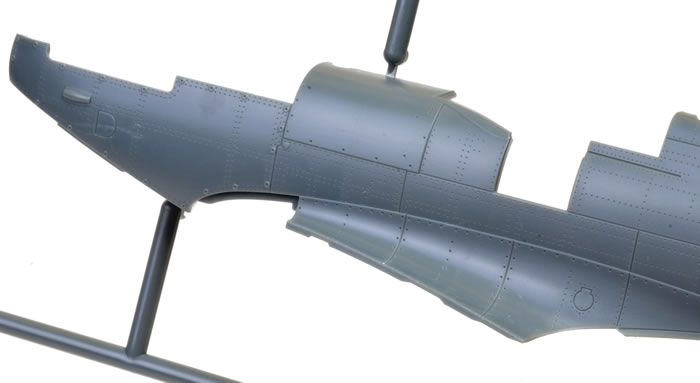
Compared to the earlier Mk.IX releases, this kit features an all-new wing and fuselage. No jigsaw inserts and hard-to-fill joins here!
The new fuselage has the tail wheel opening and well moulded in place.
It is also important to note that the wing is not the same as Eduard's previous Mk.IX wings. This all-new wing accurately depicts the short ailerons, the filler ports and the leading-edge wet wing panel lines that were specific to the Mk.VIII. This is really nice attention to detail by Eduard.
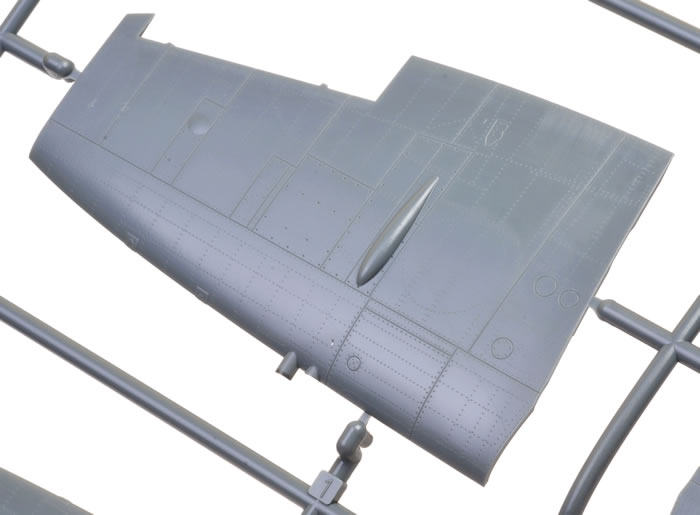
The late-style narrow gun bulges are moulded direct to the top wing halves, and the appropriate shell ejector ports are similarly moulded in place on the bottom of the wings.
HF pointed wing tips are also supplied for the first time.
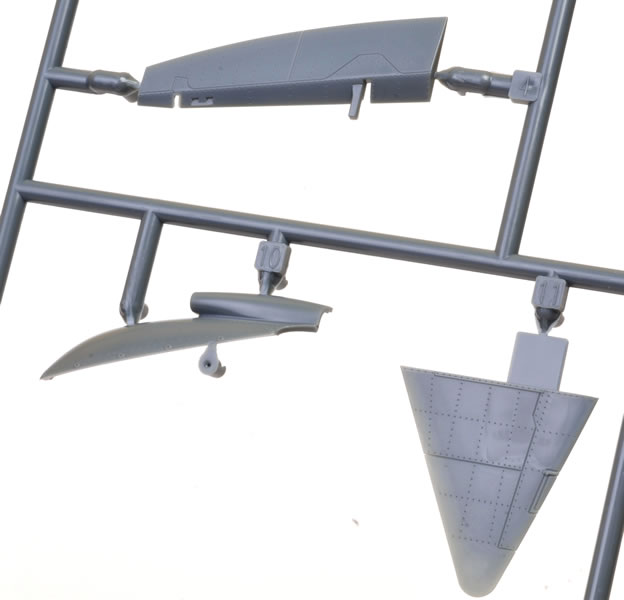
The remaining plastic sprues are the same as the Mk.IX kits, so you’ll have some bonus early Spitfire IX parts for the spares box.
In common with the earlier Eduard Spitfire releases, panel lines are very crisp, fine and even. Lines of rivets are present, but they are incredibly subtle. These are amongst the best surface detail I’ve seen on any model.
Eduard combines plastic and colour photo-etched parts in their ProfiPACK series, delivering a very high level of detail straight from the box. The cockpit benefits most from the photo-etch with a nice multi-layered instrument panel, coloured harness straps and scale-thickness pilot's armour.
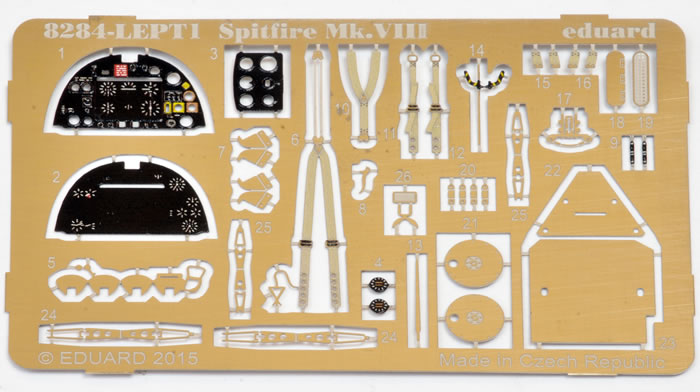
Eduard has not attempted to colour the armour plate, which I think is a good call considering the amount of interpretation that might be applicable to British Interior Grey Green!
The 17 clear parts aren't all used, but they do include different parts for open and closed canopies.
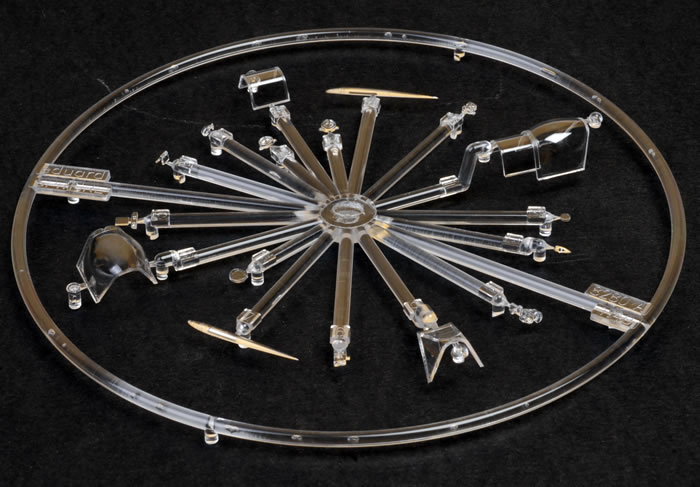
The wheel wells and undercarriage parts are really well detailed. The wheel well openings are slightly oval in shape. This seems to correspond with the shape shown in the plans in Robert Bracken's book, "Spitfire - The Canadians" (Volume One).
The exhausts are the fishtail type. They are supplied in one piece for each side and the stacks are hollowed out at the end.
Markings
New markings are supplied for six varied aircraft:
-
LF Mk.VIII, MD280, Flown by F/Lt. Paul Ostrander, No. 155 Squadron RAF, Burma, 1945
-
F Mk.VIII, JF470, 31st Fighter Group, 308th Fighter Squadron, Fano Air Base, Italy, 1944 – 1945
-
F Mk.VIII, JF330, Flown by AVM Harry Broadhurst, 1943
-
F Mk.VIII, JF404, No. 32 Squadron RAF, Foggia Air Base, Italy, Early 1944
-
LF Mk.VIII, MT714, Flown by F/Lt A. W. Guest, No. 43 Squadron RAF, Ramatuelle Air Field, France, August, 1944
-
HF Mk.VIII, Flown by W/C Robert Gibbes, CO of No. 80 Fighter Wing, Dutch East Indies, 1945
Everything is in register on the Cartograf-printed sheet and colours look good.
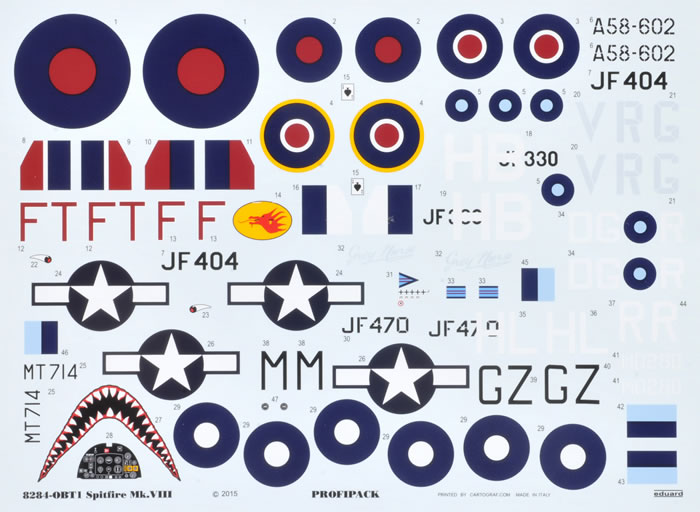
For Bobby Gibbes' shark-mouth Mk.VIII, the instructions appear to show the code letters as RAF Sky but the decals themselves appear to be printed in a pale grey/blue representing (correctly) RAAF Sky Blue.
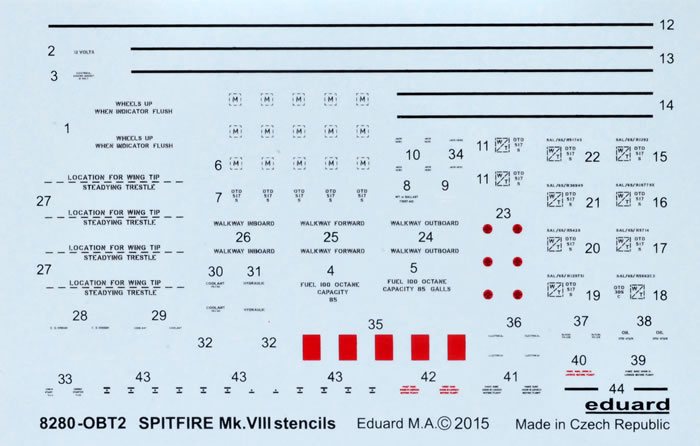
A second decal sheet supplies stencil markings.
Eduard's Mk.IX kits were the best Spitfires in 1/48 scale upon their release, and they still are today. This new Spitfire Mk.VIII is equally good.
It would have been easy to ignore some of the subtler differences between the Mk.IX and Mk.VIII, but Eduard has gone the whole nine yards with their brand new fuselage and wings depicting the unique attributes of this later variant.
Eduard's 1/48 scale Spitfires all boast a high degree of accuracy, superb surface textures, excellent detail and modeller-friendly parts breakdown. The option of a bunch of photo-etched and BRASSIN accessories, including an engine, specific Mk.VIII cockpit, fabric harness straps and "super" straps, will keep the super-detailers out there happy too.
These Spitfires showcase Eduard at the very top of their game. I'm sure we all look forward to seeing this same superlative standard extend into their forthcoming releases.
Highly Recommended.
Thanks to Eduard for the sample
Review Text Copyright © 2014 by
Brett Green
Page Created 9 March, 2015
Last updated
11 May, 2015
Back to HyperScale Main Page
Back to Reviews Page |
